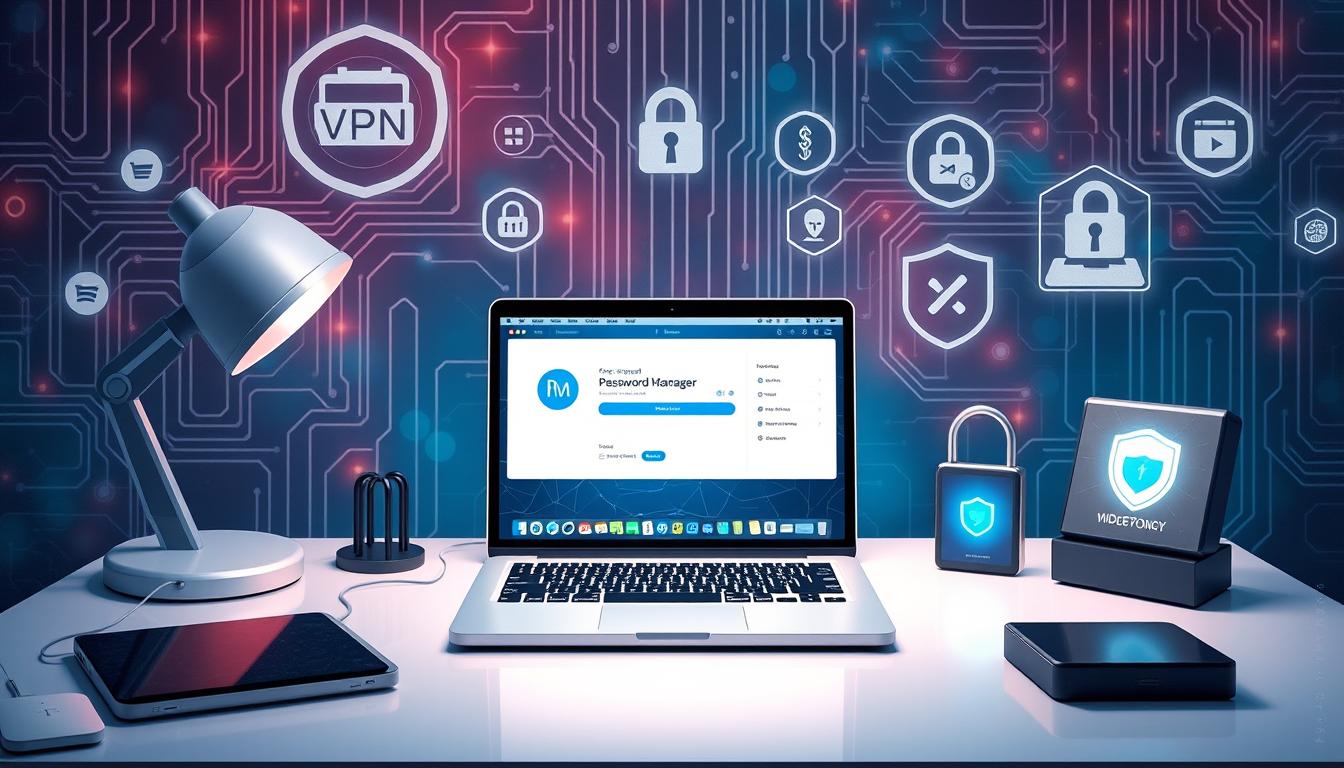Did you know insider threats cost businesses an average of $16.2 million each year1? This shows how important it is to spot insider threats. In our Day 13 Cybersecurity Training, we’ll look at the dangers inside our own companies. We’ll also talk about how to find and stop these threats.
In today’s world, threats from inside are bigger than ever. About 90% of companies face insider threats each year. And, human mistakes cause about 95% of all cyber attacks2. This means we need good training and defenses to protect ourselves from these risks.
The Center for Development of Security Excellence says an insider threat is anyone with access who harms the company. This includes both bad actors and careless employees. In fact, 55% of insider threats come from mistakes, and 25% from criminal actions1.
Understanding insider threats is key. It takes 86 days on average to stop an insider threat1. This long time can cause big financial losses and harm a company’s reputation. By focusing on finding and stopping insider threats, companies can lower their risk a lot. This is done by using strong cybersecurity measures.
Key Takeaways
- Insider threats pose a significant financial risk to businesses
- Human error is a leading cause of cybersecurity incidents
- Most organizations face multiple insider threat incidents annually
- Negligence accounts for over half of insider incidents
- Containing insider threats can take several months
- Proactive measures and training are essential for risk mitigation
Understanding Cyber Insider Threats Fundamentals
Cyber insider threats are a big problem for all kinds of organizations. A huge 68% of companies feel they are at risk. This shows how important data breach prevention and cybersecurity awareness are3.
Defining Insider Threats in Cybersecurity
Insider threats come from inside a company. They can be from current or past employees, contractors, or partners. These threats can cause a lot of damage, both financially and to a company’s reputation4.
Types of Cyber Insider Risks
There are three main types of insider threats:
- Rogues: People who mean to cause harm
- Klutzes: Employees who accidentally make security problems
- Pawns: People tricked by outside threats4
These threats can lead to data theft, IT sabotage, or fraud. They might be driven by money or revenge3. Phishing attacks are a big worry, as they can trick even well-meaning employees into opening doors to cyberattacks4.
Impact on Organizations and Infrastructure
The effects of insider threats are huge. Insider threats cause most data breaches, leading to big financial losses5. For example, Marriott Hotels had a breach that exposed over 500 million customer records, costing around £18.4 million5.
| Impact Area | Potential Consequences |
|---|---|
| Financial | Direct losses, legal fees, regulatory fines |
| Reputational | Loss of customer trust, brand damage |
| Operational | Disrupted business processes, lost productivity |
To fight these risks, companies need strong data breach prevention plans. They also need to make sure everyone in the company knows about cybersecurity.
Recognizing Insider Threats: Risks from Within
Insider threats are a big risk for companies, often ignored in favor of protecting against outside attacks6. These dangers can come from mistakes or intentional actions for personal reasons6. The damage can be huge, causing financial losses and harming a company’s reputation6.
Monitoring employees and managing who has access to sensitive data are key to spotting insider threats. Using Role-Based Access Control (RBAC) limits who can see certain data, making it safer6. Regular checks on data and security can also uncover signs of insider threats6.
Modern tools are important in finding insider threats. User and Entity Behavior Analytics (UEBA) spots odd behavior, like when someone accesses data at odd hours6. Data Loss Prevention (DLP) software stops unauthorized data sharing from secure areas6.
Remote work has made insider threats more common6. To fight this, companies should use Multi-Factor Authentication (MFA) and Virtual Private Networks (VPNs) for safe connections6. It’s also key to train employees on data security laws and rules6.
It’s important to understand why insider threats happen. People who feel their workplace is unfair are more likely to act out7. These actions can include sharing secrets, espionage, sabotage, or even violence7. Events like the Washington Navy Yard tragedy in 2013 and Edward Snowden’s leaks show the dangers of not stopping insider threats7.
To fight insider threats, finding them early and stopping them is key. The critical pathway model helps understand and tackle these threats7. It’s also important to encourage employees to speak up if they see something odd76.
Common Attack Vectors and Methods
Insider threats are a big risk for companies. They use many ways to attack. Knowing these methods helps protect against them.
Malware and Sabotage Techniques
Insiders use advanced malware to harm systems. A data breach can cost up to $4.35 million. This shows how damaging these attacks can be8.
Ransomware, a type of malware, has grown by 100% in recent years8. These attacks can stop operations and cause big financial losses.
Data Exfiltration Methods
Insiders use weak spots in security to steal data. Most breaches start with stolen or phished credentials8. Weak passwords make this risk even higher, with 85% of IT pros saying they increase breach chances8.
Social Engineering Tactics
Social engineering is key in many insider attacks. Over 90% of cyberattacks start with a phishing email8. About 25% of security incidents come from insiders, like disgruntled employees8.
This shows the importance of watching user behavior and doing regular risk checks. It helps spot and stop threats from within.
Companies need to be careful and have strong security. Regular checks, training, and advanced monitoring are key to fighting insider threats.
Behavioral Indicators and Warning Signs
Insider threats are a big worry for all kinds of organizations. They can do as much harm as cyberattacks from outside910. It’s key to spot behavioral signs to catch insider threats early.
Watching for odd login attempts from remote devices or at strange times is important9. Seeing lots of failed login attempts in logs can mean trouble9. Also, big data downloads at odd hours need checking out911.
https://www.youtube.com/watch?v=5GLNKHJCSkg
Look out for signs like poor work, money troubles, or sudden quitting9. Being mean to coworkers, showing up late, or missing work a lot are also warning signs10. Big data use, access to secret files, and using personal devices for work are red flags too10.
“Insider threats combine technological solutions with employee awareness.”
To catch insider threats, use tech like User and Entity Behavior Analytics (UEBA) and teach employees to watch each other9. Keep detailed records of IT stuff and use software to watch employee actions1011.
| Warning Sign | Description |
|---|---|
| Unusual Login Attempts | Access from remote devices or during odd hours |
| Data Transfer Anomalies | Sudden spikes in downloads or traffic |
| Behavioral Changes | Poor performance, financial distress, conflicts |
| Unauthorized Access | Attempts to access sensitive information beyond job scope |
Creating a strong cybersecurity culture and using good monitoring tools helps fight insider threats. This way, organizations can stop big problems before they start.
Privileged Access Management Strategies
Privileged access management is key to fighting insider threats. Inside, 70% of data breaches come from abusing privileged accounts12. This shows the urgent need for strong strategies to keep systems and data safe.
Access Control Policies
Setting up strict access control policies is essential. Almost 90% of security experts say users have too many privileges12. It’s important to follow a least-privilege model, giving access only when needed. Regular checks can cut down on privilege creep by 40%13.
User Behavior Analytics
User behavior analytics are key in spotting odd behavior. Using this tech can cut down threat time by 30%, helping respond faster13. These tools look for patterns to find suspicious actions, making security better.
Monitoring Privileged Accounts
Keeping an eye on privileged accounts is vital. With 61% of breaches due to bad credential management, watching closely is key12. Using multi-factor authentication and regular audits can lower risks a lot.
| Strategy | Impact | Implementation Rate |
|---|---|---|
| Access Control Policies | 40% reduction in privilege creep | 65% |
| User Behavior Analytics | 30% reduction in threat dwell-time | 45% |
| Privileged Account Monitoring | 61% reduction in credential-related breaches | 55% |
Good privileged access management needs a mix of strategies. By using these methods, companies can lower insider threat risks and keep their valuable assets safe from breaches.
Building a Robust Security Culture
A strong security culture is key to fighting insider threats. It’s important to teach all employees about cybersecurity. This is because insider threats cause 34% of data breaches14.
It’s tough for companies to fight insider risks. 76% say growing business and IT complexity make them more vulnerable14. So, everyone in the company needs to work together on cybersecurity.

It’s important to have regular security training. These sessions should teach:
- How to spot threats
- What security rules are
- How to report odd activities
It’s also key to have clear ways for employees to report security issues. Sadly, only 13% of insider threats are caught by coworkers14. This shows we need a place where everyone feels safe to report things.
Insider breaches cost a lot, about $15 million a year on average14. Spending on security is not just for safety; it’s also smart money. By building a culture of security, companies can lower their risks and keep their valuables safe.
Regular checks and audits are important for a strong security culture. They can cut insider threat risks by up to 40%15. By always checking and improving security, companies can stay safe from threats.
Implementing Detection and Prevention Measures
To stop data breaches, companies need strong tools and plans. Insider threats are growing, with 76% of companies hit in 2024, up 10% from 201916. This shows the importance of good incident response planning.
Security Information and Event Management (SIEM)
SIEM systems are key in spotting insider threats. They send out alerts for odd activities, which is faster than manual checks17. By watching for signs like strange data access or logins at odd hours, SIEM finds risks early.
Data Loss Prevention Tools
Data Loss Prevention (DLP) software is key for watching all endpoints. It stops unauthorized data access, a big part of stopping breaches18. DLP is very important because 60% of breaches come from insiders18.
Incident Response Protocols
Having good incident response plans is essential. This includes using multi-factor authentication and the least privilege rule16. Also, doing security checks at least once a year keeps defenses strong against insiders16.
| Measure | Purpose | Impact |
|---|---|---|
| SIEM | Automated threat detection | Early risk identification |
| DLP | Endpoint monitoring | Unauthorized access prevention |
| Response Protocols | Structured incident handling | Minimized breach impact |
By using these steps, companies can make their data breach prevention better. They can also improve how they handle incidents.
Risk Assessment and Management Framework
In the world of cybersecurity, having a strong risk assessment and management framework is key. Organizations face new threats that can cause big financial losses and harm their reputation. The average cost of a data breach in 2024 was $4.88 million, showing why proactive risk management is vital19.
Threat Assessment Methodologies
Good threat assessment means spotting risks from different places. Insider risks often come from careless mistakes, bad actions, or hacked accounts20. Without watching user actions, up to 70% of insider threats might not be caught20.
Vulnerability Management
Vulnerability management is a big part of risk assessment. It’s important to follow the principle of least privilege. Studies show that 80% of data breaches happen because users have too much access20. Regular, detailed risk assessments help keep up with fast-changing threats19.
Risk Mitigation Strategies
It’s vital to have good risk mitigation strategies. Companies hit by insider threats might see their cybersecurity insurance costs go up by 20%20. Using frameworks like NIST or ISO is a good start for managing risks19. Teaching employees about security can also make a company’s cybersecurity better19.
Using tools like Microsoft Purview Insider Risk Management can help spot insider risks. This includes things like IP theft and data leaks, by looking at different signals21. With the right insider risk policies, a company can get much better at managing risks.
Employee Training and Awareness Programs
Employee training is key to fighting insider threats in companies22. In 2019, 66% of companies faced insider attacks, rising to 76% in 202423. To tackle this, training is a mainstay of defense24.
Good insider risk training covers all threat types. It teaches that risks come from both bad intent and mistakes22. This is vital, as nearly half of insider threats come from careless actions23. Training should teach employees to spot signs like unauthorized access and odd behavior22.
Training must teach employees how to handle data securely22. This includes using strong passwords, multi-factor authentication, and encryption24. It’s also important to have clear ways for employees to report suspicious activities22.
Keeping employees informed through newsletters and training keeps them aware of security2224. This is critical, as insider threats cost an average of $15.38 million in 202223. Combining tech with trained staff boosts a company’s security against insider threats22.
Conclusion
Dealing with insider threats is a big challenge in cybersecurity. The world of insider threats has changed a lot. Now, 83% of companies say they’ve faced insider attacks in 202425.
This rise in attacks shows we need better ways to stop and find them. It’s a big problem that needs quick solutions.
The money lost to insider threats is huge. In North America, the damage went up by 95%, hitting $19 million26. These numbers show how serious the threat is. It can lead to big data breaches, stolen ideas, and legal problems that hurt a company’s success and money25.
To fight these threats, companies need to take many steps. They should use Zero Trust security, advanced analytics, and teach their employees about security2526. Training workers helps a lot, as most insider risks come from mistakes, not bad intentions26.
By using these methods, businesses can lower their risk of insider attacks. They can protect their important data and keep their place in the digital world.
FAQ
What is an insider threat in cybersecurity?
How can organizations detect insider threats?
What are some common indicators of a possible insider threat?
How can privileged access management help prevent insider threats?
What role does employee training play in preventing insider threats?
How can organizations balance security measures with employee privacy concerns?
What are some effective incident response strategies for insider threats?
How can risk assessment help in managing insider threats?
What technologies are most effective in preventing data breaches caused by insiders?
How can organizations create a culture that encourages reporting of possible insider threats?
Source Links
- Mitigating Insider Threats: Your Worst Cyber Threats Could be Coming from Inside – https://www.aon.com/en/insights/articles/mitigating-insider-threats-your-worst-cyber-threats-could-be-coming-from-inside?collection=3ab7b09b-e783-4c99-b960-0be73fb4fa49&parentUrl=/en/capabilities/human-capital-analytics/renew-your-participation-to-the-radford-mclagan-compensation-database
- Cybersecurity in the Modern Era: A Comprehensive Guide to Mitigating Human Errors, Insider Threats, and Social Engineering Attacks – https://www.linkedin.com/pulse/cybersecurity-modern-era-comprehensive-guide-mitigating-human-xxeue
- Understanding Insider Threats · Tricent Blog – https://www.tricent.com/blog/understanding-insider-threats/
- From the Inside Out: Understanding and Responding to Insider Threats – https://www.ftitechnology.com/resources/blog/from-the-inside-out-understanding-and-responding-to-insider-threats
- Insider Threats in Cybersecurity | Splunk – https://www.splunk.com/en_us/blog/learn/insider-threats.html
- Insider Threats: Identifying and Mitigating Risks from Within – https://www.linkedin.com/pulse/insider-threats-identifying-mitigating-risks-from-within
- Insider Threat Awareness: Strengthening our Defense – https://www.warren.af.mil/News/Article/3897927/insider-threat-awareness-strengthening-our-defense/
- What is an Attack Vector? 16 Critical Examples | UpGuard – https://www.upguard.com/blog/attack-vector
- 5 Insider Threat Indicators and How to Detect Them – https://pathlock.com/learn/5-insider-threat-indicators-and-how-to-detect-them/
- Detecting Insider Threat Indicators | CrowdStrike – https://www.crowdstrike.com/en-us/cybersecurity-101/identity-protection/insider-threat-indicators/
- Insider Threat Indicators: 10 Warning Signs to Look For – https://www.teramind.co/blog/insider-threat-indicators/
- Minimalize Privileged Access Management security risks – https://www.oneidentity.com/community/blogs/b/privileged-access-management/posts/staying-ahead-of-privileged-access-management-security-risks-success-strategies
- Insider Threat Prevention Best Practices – https://www.netwrix.com/insider-threat-prevention-best-practices.html
- Secure Human Behavior – Recognizing and Reporting Insider Threats – Keepnet – https://keepnetlabs.com/blog/secure-human-behavior-recognizing-and-reporting-insider-threats
- Insider Threats and Prevention Strategies – https://www.isc2.org/Insights/2024/08/Insider-Threats-and-Prevention-Strategies
- How To Detect, Mitigate, & Prevent Insider Threats – https://purplesec.us/learn/prevent-insider-threats/
- Insider Threats in Cyber Security: How to Detect & Prevent | UpGuard – https://www.upguard.com/blog/insider-threat
- 17 Ways To Prevent Insider Threats: Steps, Tips & Tools – https://www.teramind.co/blog/how-to-prevent-insider-threats/
- What Is Cybersecurity Risk Management? – https://online.utulsa.edu/blog/what-is-cybersecurity-risk-management/
- A Comprehensive Guide To Insider Risk Management – https://www.teramind.co/blog/insider-risk-management/
- Learn about insider risk management – https://learn.microsoft.com/en-us/purview/insider-risk-management
- Training Employees to Recognize and Report Insider Threats – https://www.linkedin.com/pulse/training-employees-recognize-report-insider-threats-shadowsight-6rg2f
- Insider Threats: Safeguard Against Internal Risks – https://www.oneleet.com/blog/insider-threats
- Training Employees to Identify Insider Threats – https://www.lepide.com/blog/training-employees-to-identify-insider-threats/
- The Risks and Mitigation of Insider Threats | Gurucul – https://gurucul.com/blog/risks-and-mitigation-of-insider-threats/
- Distinguishing and Understanding Insider Threats – Westoahu Cybersecurity – https://westoahu.hawaii.edu/cyber/forensics-weekly-executive-summmaries/distinguishing-and-understanding-insider-threats/









